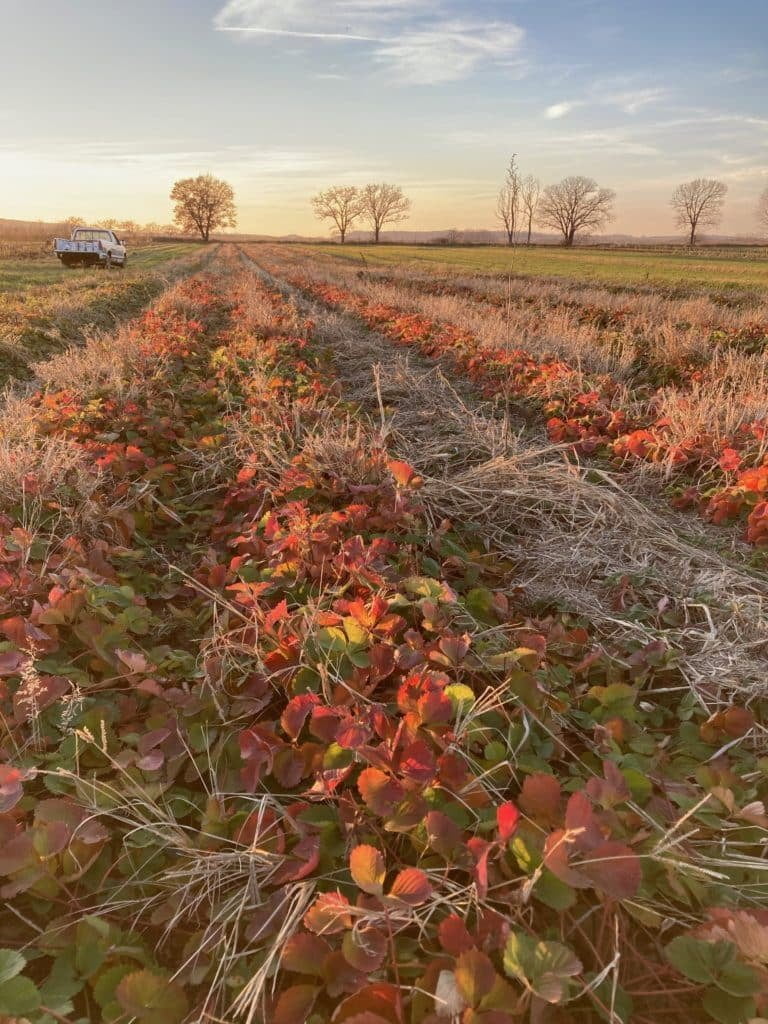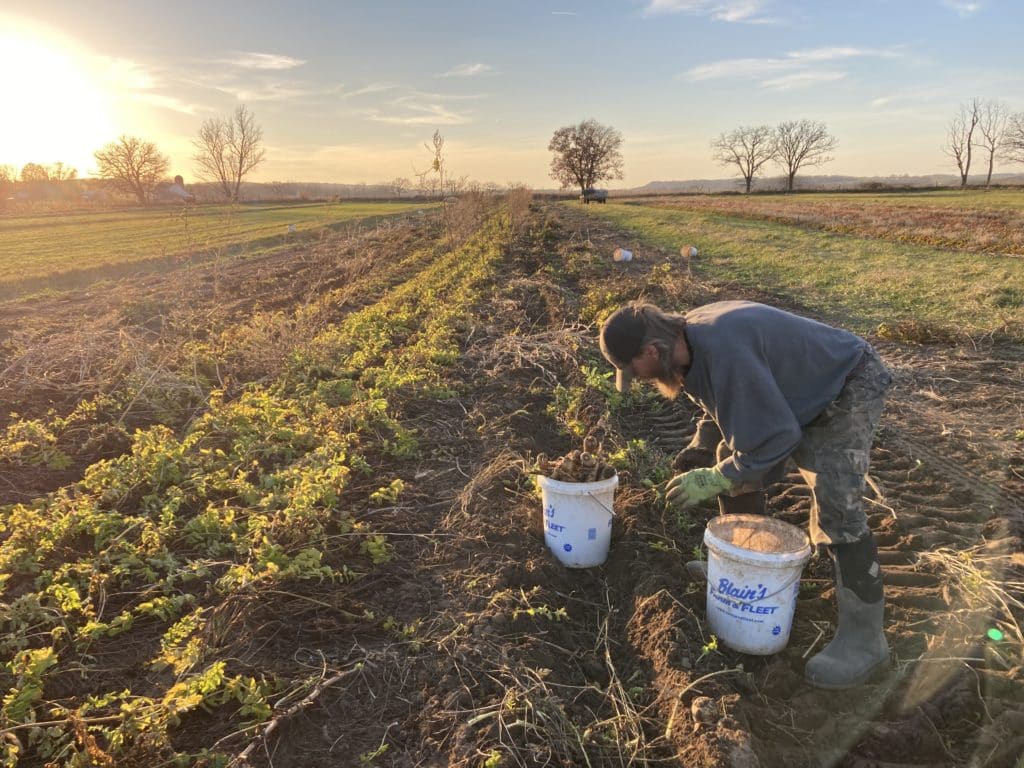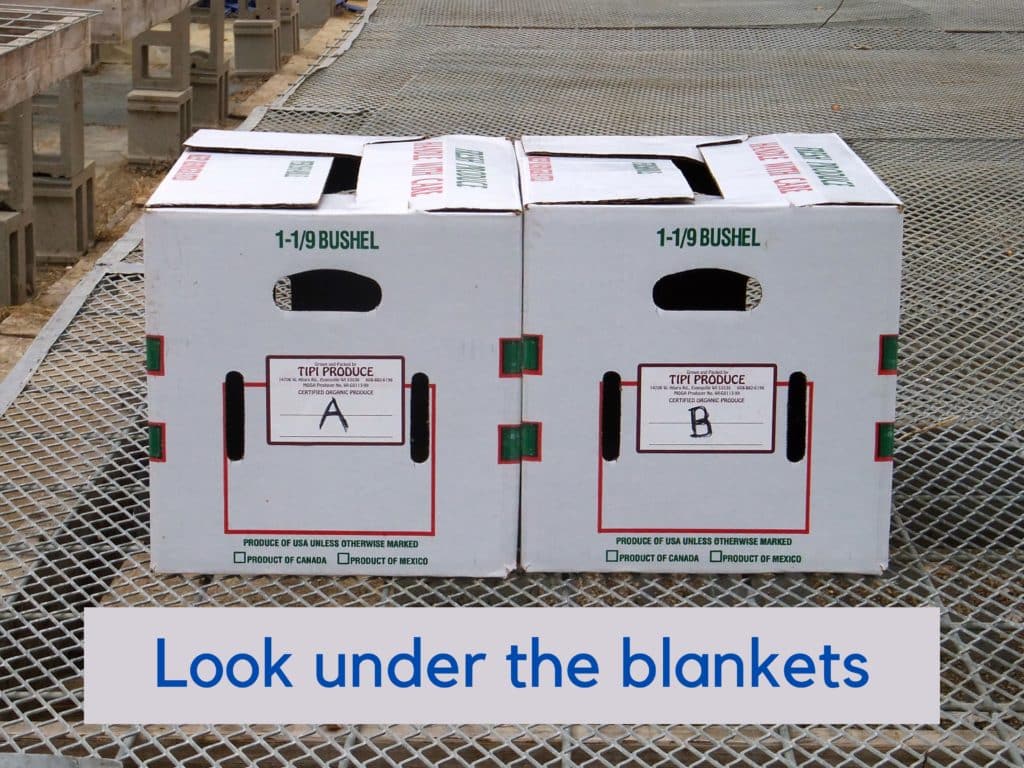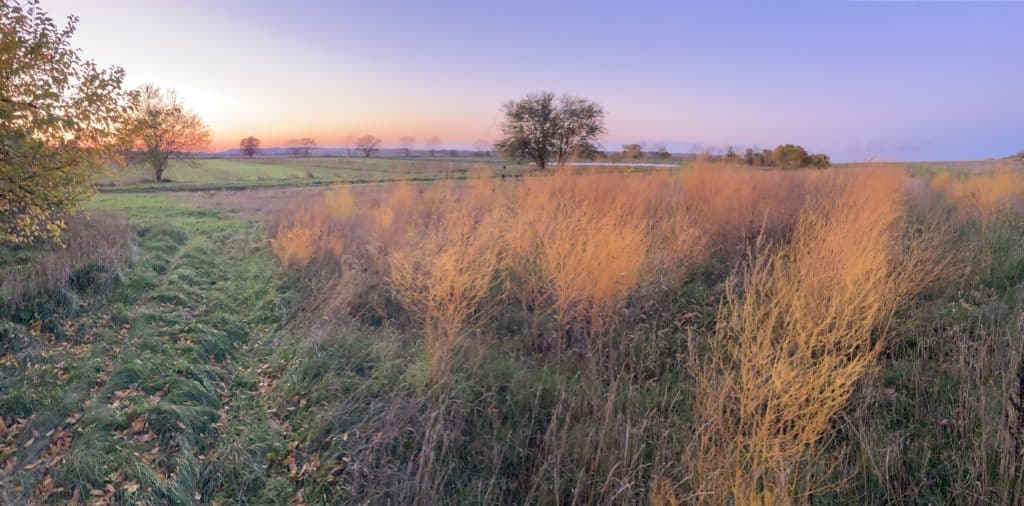Monthly Archives: November 2023
Storage Share, 2023
- On: November 15, 2023
 0
0

Even the strawberry plants are showing fall colors.

We are using the mild weather to bring in fall bumper crops. Here, Ken picks up stray parsnips. The harvester picks up most roots but some are skipped. The parsnips go into cold storage. We’ll wash and ship to food coops through the winter, plus carrots, cabbage, radishes, celeriac, turnips, etc etc.
Storage Share this week

Your produce is in one box labelled “A” and one box labelled “B”. Bring lots of bags and containers.
Things you need to know about your winter share
* Your delivery will consist of two different boxes, labeled “A” and “B”. Take produce from one “A” box and one “B” box. The boxes contain different vegetables. The stacks may be covered with blankets. Look around.
* Please pick up your boxes on the day of delivery, during the normal hours for your site.
* Bring extra bags or containers this time. Leave the Tipi boxes at your site, take the produce home in your own bags/containers.
* If you send someone to pick up your produce, make sure they know what to do.
Strategy
We hope you enjoy this shipment of veggies. Strategize to use them well, as some will last longer than others.
* These are the most perishable vegetables: Fennel, Romanesco.
* These are the next-most perishable: Brussels sprouts, leeks.
* Onions are next in line. We sent you our best long-storing onions but you should still store them cool if possible (but don’t let freeze). If you don’t have room in your fridge, find a cool spot in your house.
*Keep an eye on your butternut, potatoes and sweet potatoes. These last well but the last two are susceptible to drying out. Expect the largest butternuts to last the longest.
* These will last the longest: beets, cabbage, carrots, celeriac, daikon, garlic, parsnips and shallots.
Veggie List
Storage Share, Nov. 16/17, 2023 (Th/Fri sites)
Box “A”
Everything in this box can be stored cool or at room temperature. See notes below for more detail.
Garlic, 3 – 4 bulbs, some bulbs might be split in half
Shallots, 1 or 2
(Garlic and shallots are in same bag.)
‘Autumn Frost’ winter squash
Butternut squash, several
(Combined, squash are ~10 lb total)
Sweet potatoes, ~10 lb
Onions, red & yellow, 5 lb total
Russet potatoes, 5 lb
Yellow potatoes, 5 lb
Box “B”
Refrigerate everything in this box.
Beets, 3 lb, mixed red and golden
Brussels sprouts, 1.5 lb
Cabbage, 1 head
Carrots, 6 lb mixed orange, red, yellow & purple
Celeriac, 1
Daikon radishes, white & purple & red
Fennel, 1 bulb
Leeks, ~2 lb
Parsnips, 2 lb
Romanesco cauliflower, 1 head
Beets – Your bag will have mostly red beets, with a few golden beets mixed in. Refrigerate in a bag or container. Beets will store for two months or longer.
Brussels sprouts – Eat within 2 to 3 weeks.
Cabbage – Refrigerate. You can cut off sections as needed.
Carrots – Refrigerate in a plastic bag. Will keep for weeks.
Celeriac – Will store for months in your fridge. Cut off chunks as needed. Peel before using. I find it easiest to cut the celeriac into flat slices, then peel.
Daikon radishes (white, purple, red) – Cover and refrigerate. They are susceptible to drying out in your fridge so put them in a container or bag. If the skins look dry, a quick peel freshens them up.
Fennel – Cover and refrigerate.
Leeks. Refrigerate. In general, leeks are not a long-storage crop. You may need to strip off one or two outer leaves to freshen the leeks before you cook them.
Garlic – Store at room temperature. We’re sending a mix of large and small bulbs, German Extra Hardy (white wrapper leaves, large cloves) and Korean Red (purple wrapper leaves, smaller cloves). Some bulbs might be in halves, leftover from when we cracked nice bulbs for planting.
Onions: Refrigerate or store in a cool, dark spot and protect from light. Exposure to light stimulates sprouting.
Parsnips (These look like large white carrots.) – Refrigerate in a plastic bag. Parsnips will store for several months but will darken in color. That is a harmless change.
Potatoes – Can be stored at room temperature or in a cool spot, but must be kept in the dark so they do not turn green. A cloth or loose plastic bag draped over the paper bag will slow moisture loss, but do not close the plastic bag. Potatoes store longer if kept cool. Around 40 – 50 F is ideal. These organic potatoes were grown by the Igl family near Antigo.
Russets – We got the big ‘baking’ grade so you have nice bakers for Thanksgiving. Excellent for baked or mashed potatoes.
Yellows – These are good all-purpose potatoes.
Romanesco cauliflower – Refrigerate. These should store for two weeks.
Shallot (look like a small red onion) – Good for salad dressing or to caramelize.
Sweet potatoes – We’re sending a mix of two indistinguishable varieties, Beauregard and Orleans. Both have excellent flavor and sweetness. Store at room temperature, no lower than 55 F, but 60+ F is better. Keep them on your kitchen counter where it’s easy to keep an eye on them. I like to keep ours in a paper bag so they don’t dehydrate. Cook promptly if they start to soften. The roots come in a wide ranges of sizes and all are good.
WINTER SQUASH – Store all winter squash cool and dry. 60 F is ideal. Do not put in a plastic bag. Check your squash regularly and eat promptly if flaws develop.
Autumn Frost (frosted pumpkin) – This beautiful frosted squash has both pumpkin and butternut squash breeding. It cooks and tastes like an unusually good butternut, with rich, smooth texture. The skin is edible.
Butternut winter squash (tan, oblong) – All are our favorite ‘Metro’ variety. If your butternuts show signs of drying or wrinkling, use them promptly. They will still taste great, but it’s a sign that they are nearing the end of their storage life. Remember, you can cook, mash and freeze the squash for future use. I find that you can refrigerate cut raw squash for up to one week. This runs counter to the accepted way to store squash, but is useful if you want to cook just half a squash. Some of them are big!
Safety tip: Microwave your squash for one to two minutes before cutting or peeling. This softens the squash and makes a squash easier and safer to cut.
Thanksgiving Menus
Right now, websites are loaded with great recipes suited to your Storage Share vegetables. Peruse and bookmark soon. The Thanksgiving collections are taken down quickly after the holiday but individual recipes are not. This is a good chance to gather recipes to try this winter.
Smitten Kitchen
You could begin and end your Thanksgiving planning with Deb Perelman. She’s an amazing cook who publishes workable recipes. She has an extensive list of Thanksgiving dishes collected over the years. I really trust her recipes.
Food52.com
Check out their Automatic Holiday Menu Maker. They have collected soooo many vegetable and salad recipes, especially under the Soups & Salads and the Vegetables sections but also Hors D’Oeuvres and Main Attractions. I am relieved to see that they stripped out the ads this year. This section was overrun last year and disappointing.
Love & Lemons
They have a beautiful collection of “50 Thanksgiving Side Dishes”.
Squash & Sweets Share
- On: November 02, 2023
 0
0

Golden asparagus ferns at dusk.
Squash & Sweets Share
– November 2 / 3, 2023 (Thurs/Friday sites)
– These pre-ordered boxes will be available during the usual hours for each CSA sites.
– If you chose a new site for this week, please make sure you have updated site info from me. If you don’t have that info, just ask me.
Veggie List & Veggie Notes
Sweet potatoes, about 10 lbs
Winter squash, about 16 lbs.
The sweet potatoes are washed but the winter squash is only brushed and has some soil. Thanks for washing your squash this year!
Sweet potatoes (about 10 lb) – These are either Beauregard or Orleans variety, which are virtually indistinguishable.
Storage: Store covered at room temperature. 60 F is ideal. I store mine in a paper bag or cardboard box to slow moisture loss a bit. Sunlight does not harm them.
Winter squash (about 16 lb total) – We packed two Autumn Frost and the balance is butternuts.
Storage: All should be stored uncovered at room temperature. 60 F is ideal. Your kitchen counter or shelves are perfect. Keep an eye on the squash. If you see a flaw developing, cook that squash first.
Safety tip: Microwave your squash for one to two minutes before cutting or peeling. This softens the squash and makes it easier and safer to cut.
‘Autumn Frost’ squash – This beautiful frosted squash has both pumpkin and butternut squash breeding. They cook and taste like an unusually good butternut, with rich, smooth texture. This is a fairly new variety. The breeders really knocked it out of the park with this one. The skin is edible.
Butternut squash – The workhorse of squash! We are sending the flavorful ‘Metro’ variety, good for roasting or soups or casseroles or baked goods.



